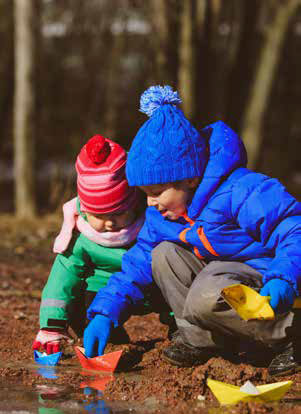Regulatory Models - New Jersey and New York 19
Some states have adopted licensing regulations incorporating general site and location criteria that could be used to address proximity to environmental hazards.[19]. Two states (New Jersey and New York) currently have specific requirements for ECE program applicants to submit written certification or documentation of any necessary environmental inspections/testing. New York and New Jersey adopted new regulations mostly in response to highly publicized exposures to environmental hazards in ECE program [44].
The New Jersey regulatory approach was enacted after the Kiddie Kollege incident (see Chapter 2). New Jersey amended its state licensing regulations to require that child care centers cannot be located near or next to areas that the Office of Licensing determines to be hazardous to the physical health and safety of the children[45]. New Jersey also has guidelines about environmental conditions that apply when a child care center is renewing its license or relocating. The guidelines require the owner of the child care facility to submit written certification to the Office of Licensing as to whether the building was ever classified as “factory/industrial, high hazard, storage, dry cleaners or nail salons, gas stations, or funeral homes.” If the child care center was classified as any of those, a licensed indoor environmental consultant also must perform an indoor environmental health assessment (IEHA). The IEHA is submitted to the Department of Health for review, and the facility owner contacts the Department of Environmental Protection to determine whether additional steps and corrective actions are needed to address the risks of the location of the child care center [45].
Links to Information on New Jersey and New York State’s Regulatory Programs
New Jersey: Environmental Guidance for All Child Care Facilities and Educational facilities is available at http://www.state.nj.us/dep/dccrequest/
New York: Guidance from the New York State Office of Children and Family Services is available at http://ocfs.ny.gov/main/documents/docschild care.asp
As stated above, Jackson Steel is a federal National Priorities List Superfund site, with a potential for causing indoor air exposures to the Tutor Time daycare center. Because of the issues at the Tutor Time site, the New York State Attorney General’s Office released a report giving recommendations on how to prevent similar events from occurring. The recommendations included ideas such as EPA asking schools and ECE programs located near Superfund sites to notify parents of children using those programs about the proximity of Superfund sites [23].
By 2005, New York amended the state licensing regulations to require ECE programs to have certification that the program, its property, and the surrounding environment was free of environmental hazards. If the historic or current use of the property indicates that environmental hazards are present, inspection and testing must be done[46].
New Jersey and New York both require that information about environmental hazards be submitted as part of the licensing and renewal process. However, New York does not have statutory or regulatory provisions requiring that license applicants obtain review by other state agencies. The state’s approach relies more heavily on the applicant to determine whether environmental hazards necessitate the involvement of other agencies [19]. More specific details of the New York and New Jersey approaches can be found at: http://www.eli.org/research-report/reducing-environmental-exposures-child-care-facilities-review-state-policy.

Several other states have adopted licensing regulations incorporating general site and location criteria that could be used to address proximity to environmental hazards. These provisions are similar in scope, but they vary in their precise wording. Unlike the New York and New Jersey approaches, the regulations do not include an explicit requirement for applicants to submit written certification or documentation of any necessary inspections or testing [19].
New York and New Jersey both amended their regulations, mostly in response to highly publicized events of exposure to environmental hazards in ECE programs[44]. New Jersey has detailed regulatory requirements relating to environmental conditions at the site of ECE programs. Most ECE programs in New Jersey must obtain an environmental assessment of the site in connection with the licensing process; an indoor environmental assessment may also be required, depending on the facility’s prior use and current location. The cost of the assessment and license is incurred by the daycare operator. However, some grants are available to cover this expense. ECE program licensing regulations in New York require applicants to submit written self-certification that the surrounding neighborhood and environment are free from environmental hazards. If potential hazards exist, applicants must consult with the appropriate state agencies and obtain any needed inspections or testing. Several other states have general statutory or regulatory provisions prohibiting health or environmental hazards in the area of an ECE program. States can build on these models by including explicit requirements for identifying and addressing environmental hazards from current or former uses of the site or nearby facilities as part of the licensing process. State agencies can also help providers in identifying and addressing potential site hazards through formal, non-regulatory initiatives[19].
19In this section, ATSDR is referring to ECE programs as “child care” to be consistent with the language used by the states of New Jersey and New York.
- Page last reviewed: August 25, 2017
- Page last updated: August 25, 2017
- Content source:



 ShareCompartir
ShareCompartir